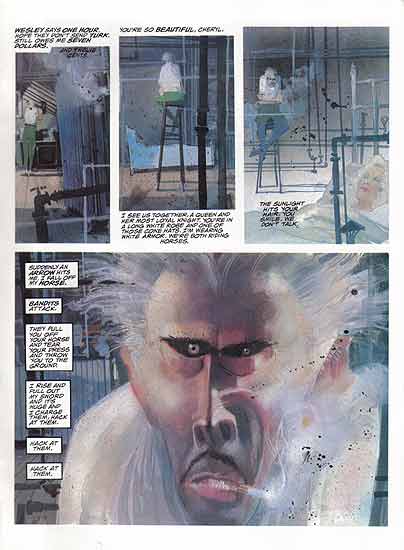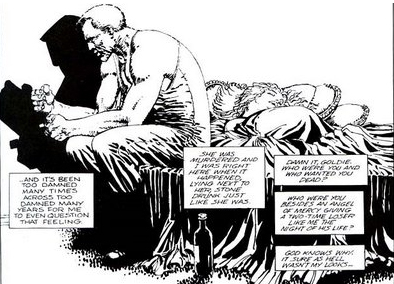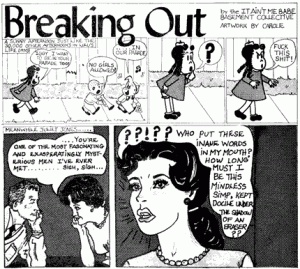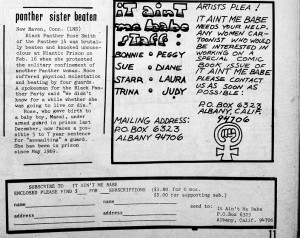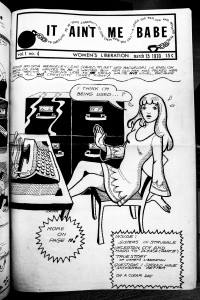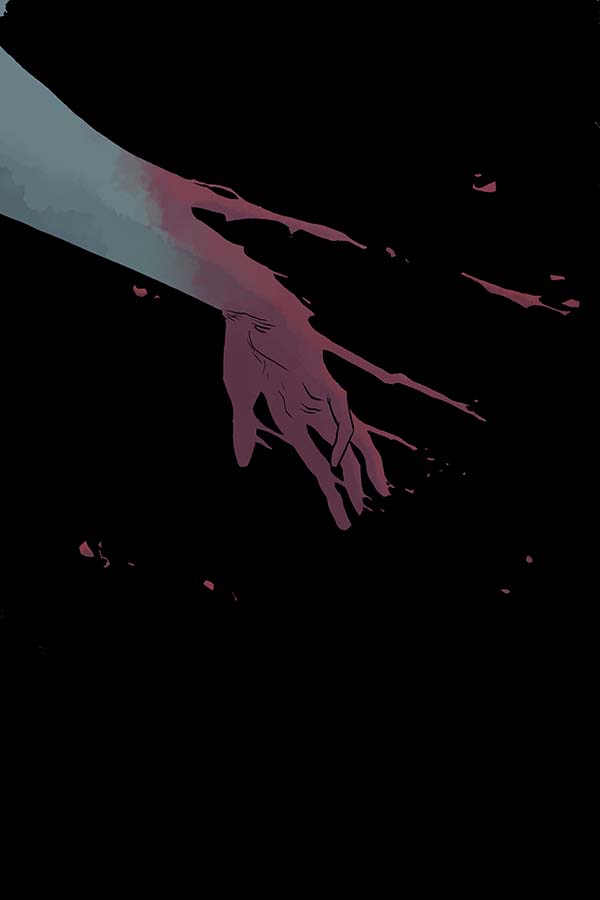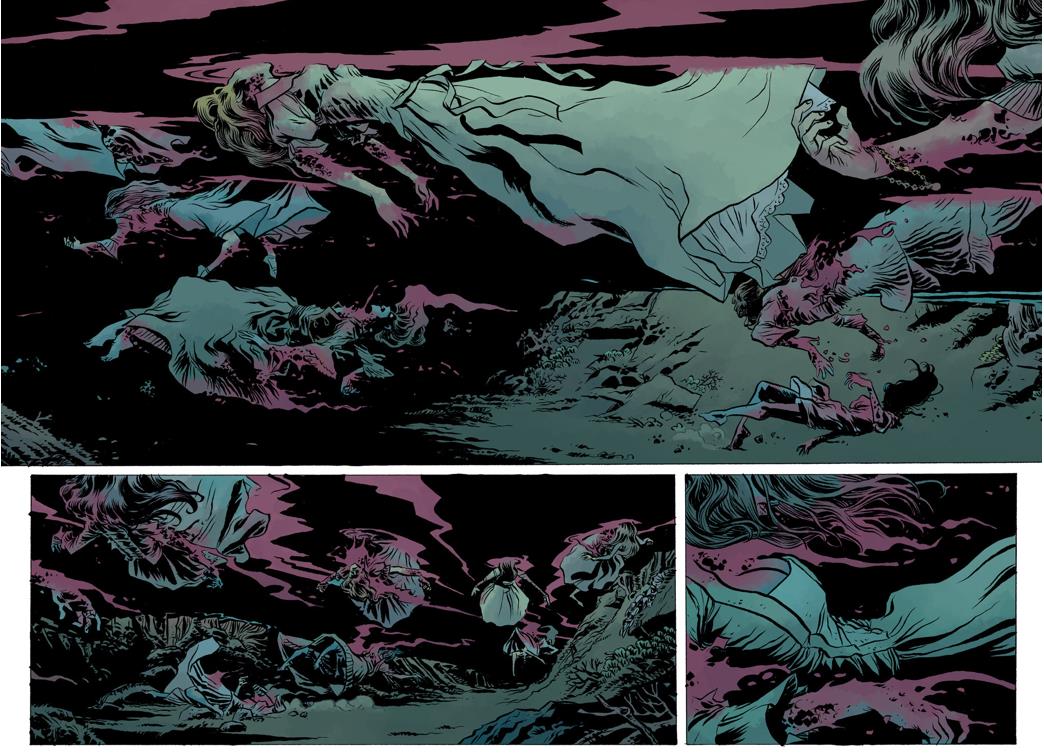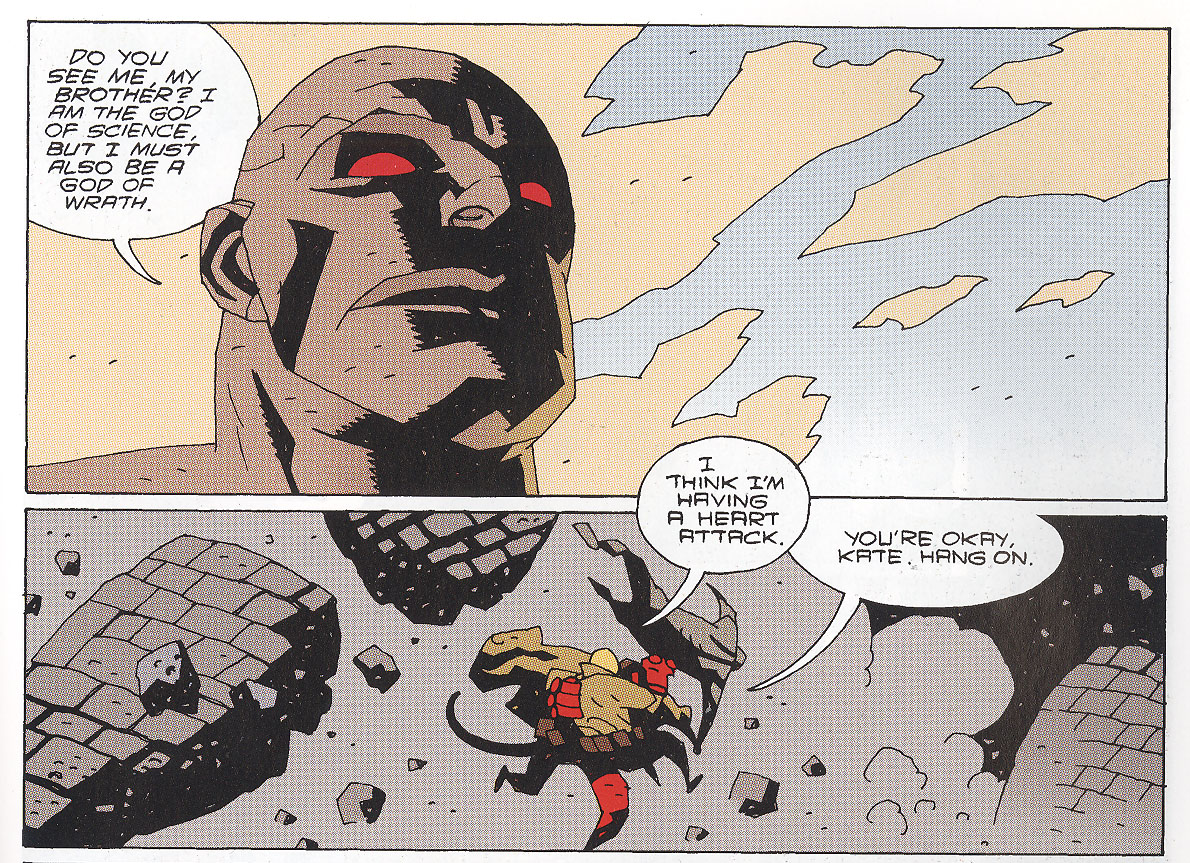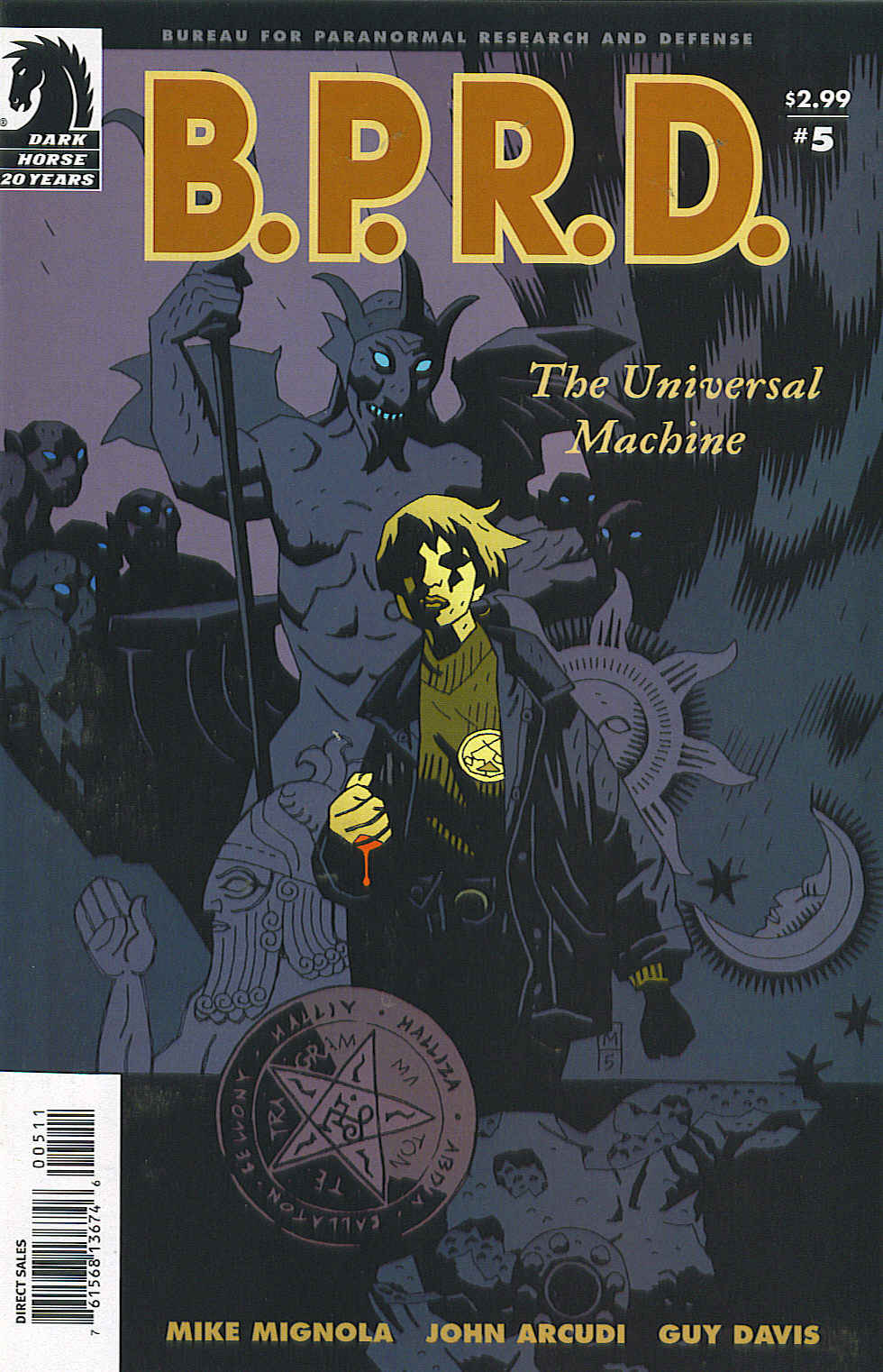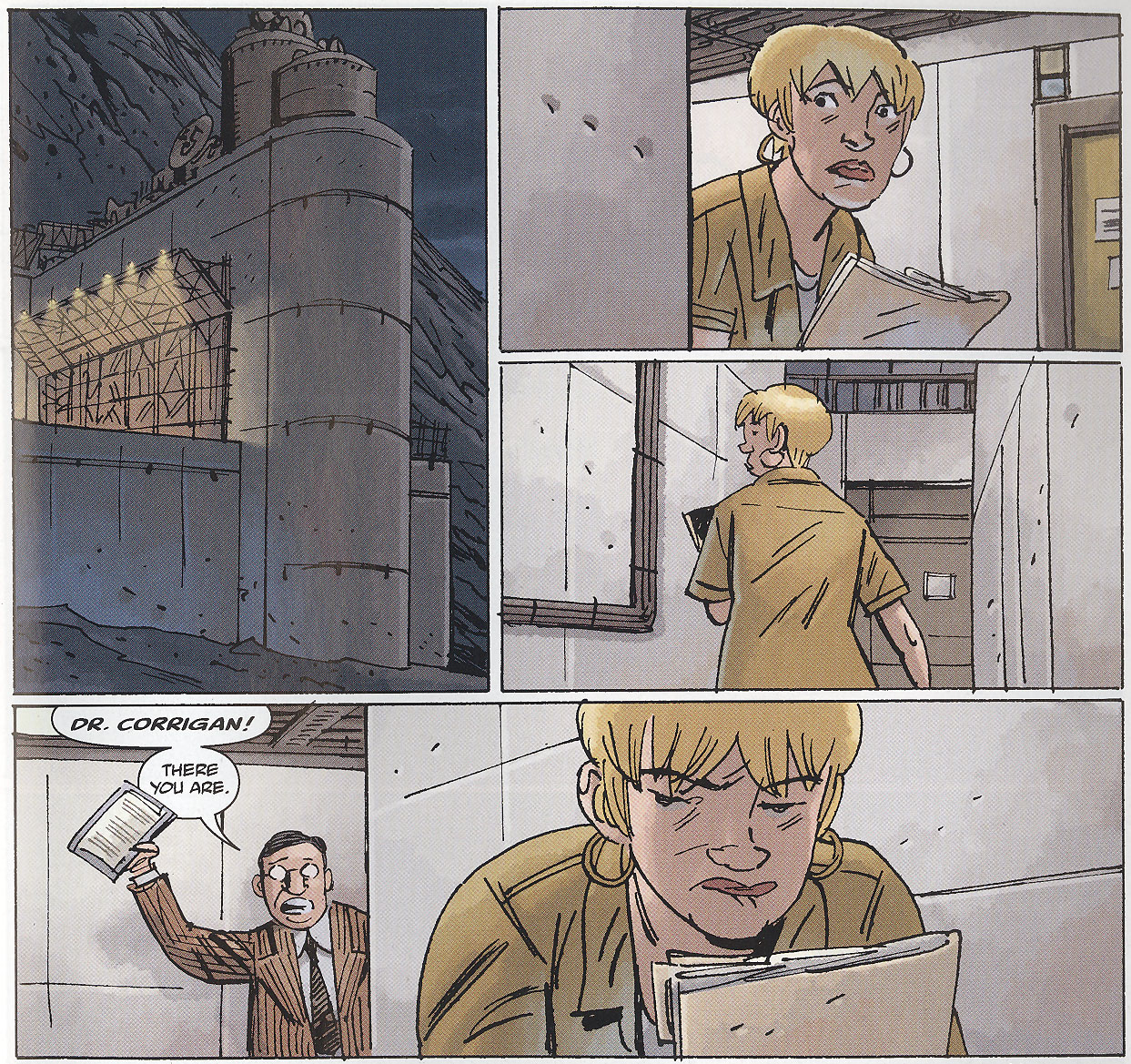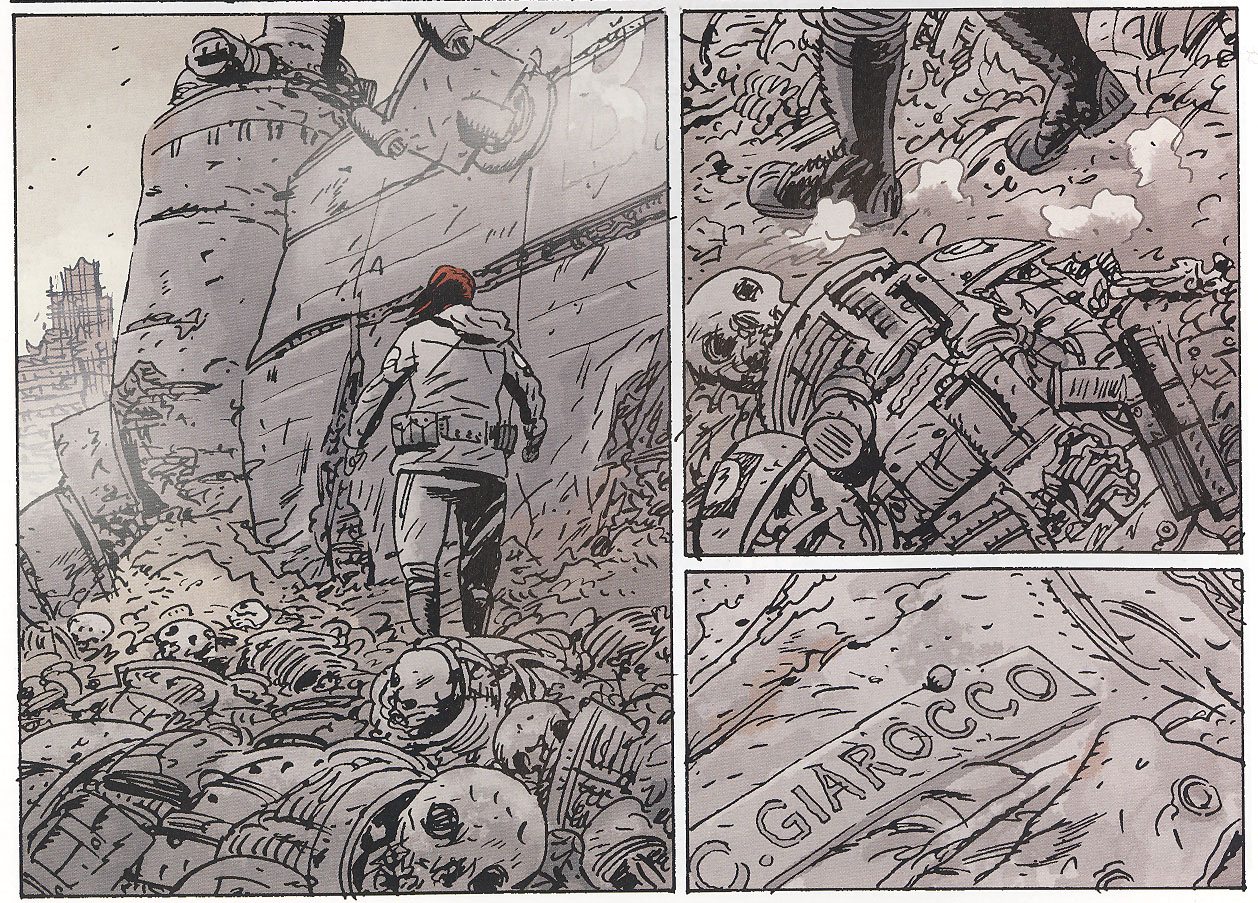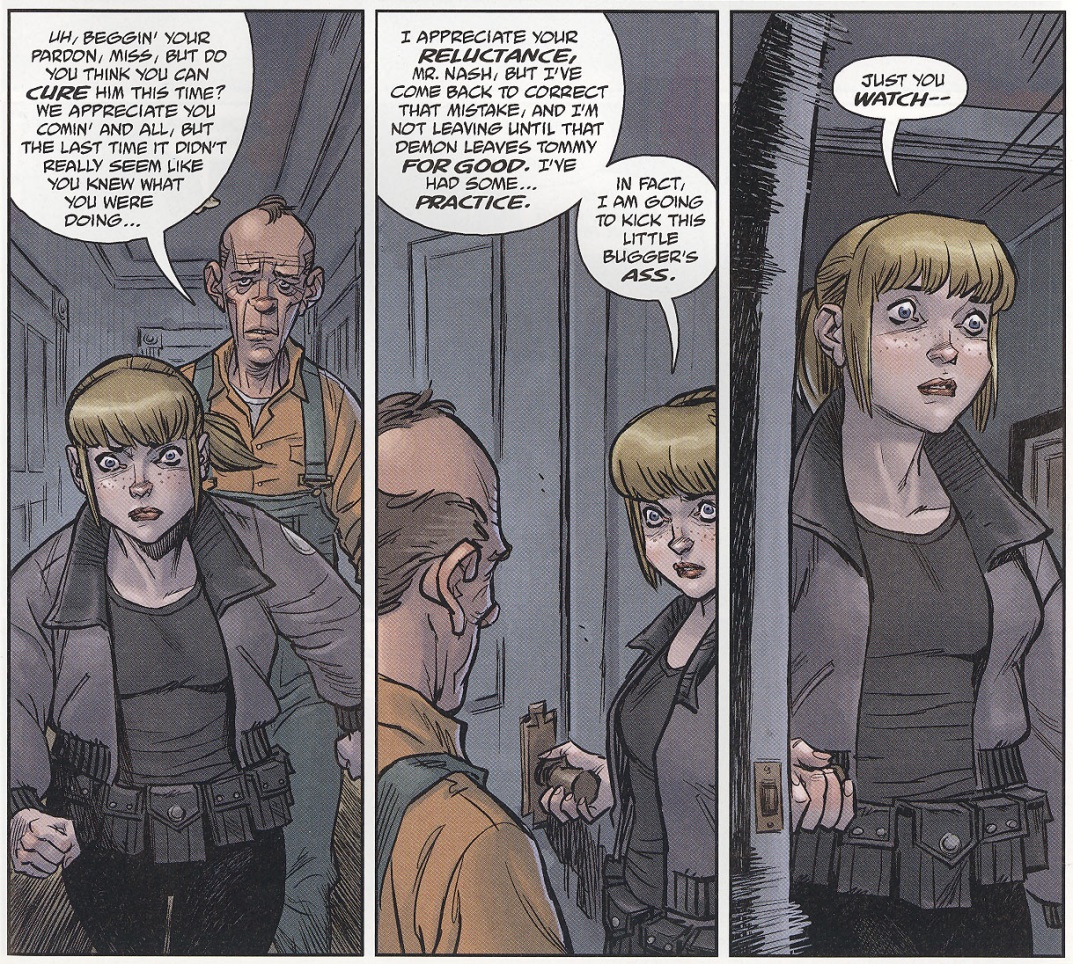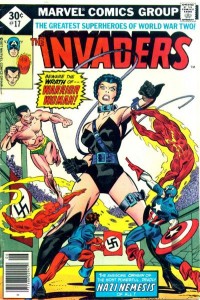This is part of the Gay Utopia project, originally published in 2007 . A map of the Gay Utopia is here.
_______
Alan Moore’s most recent glossy graphic novel is, despite its title, more akin to Lost Girls than to the two previous volumes of The League of Extraordinary Gentleman (LOEG). LOEG: The Black Dossier, like Lost Girls, is preoccupied with other creators’ fictional characters having copious amounts of sex with one another in a variety of positions. This is particularly the case in the first third of the book where Allan Quatermain (King Solomon’s Mines, etc.) and Wilhemina Murray (Jonathan Harker’s Dracula companion) have bathed in a fountain of life/immortality, which serves to make them both young, blonde, and perpetually randy. The pool may as well have been filled with liquefied Viagra, given the dramatic shift away from the subtly represented sexual dynamics between the two in both previous volumes, set some fifty years earlier. Their intermittent congresses are punctuated by excerpts from the “Black Dossier,” a government file stolen by Quatermain and Murray, which collects documents on the “extraordinary” members of the League in its various incarnations. Among these are Fanny Hill, star of a pornographic 18th century novel by John Cleland, and Virginia Woolf’s androgynous Orlando, eponymous hero/ine of the 1928 novel. Introducing Hill and Orlando as part of Leagues that both preceded and followed the turn of the Victorian century version detailed in the previous two volumes gives Moore an excuse to indulge again in somewhat graphic sexuality, particularly with Orlando, whose propensity to change gender every few centuries allows for the exploration of heterosexual couplings from either gender’s perspective, as well as frequent gay and lesbian sexual encounters, with a heavier emphasis on the latter.
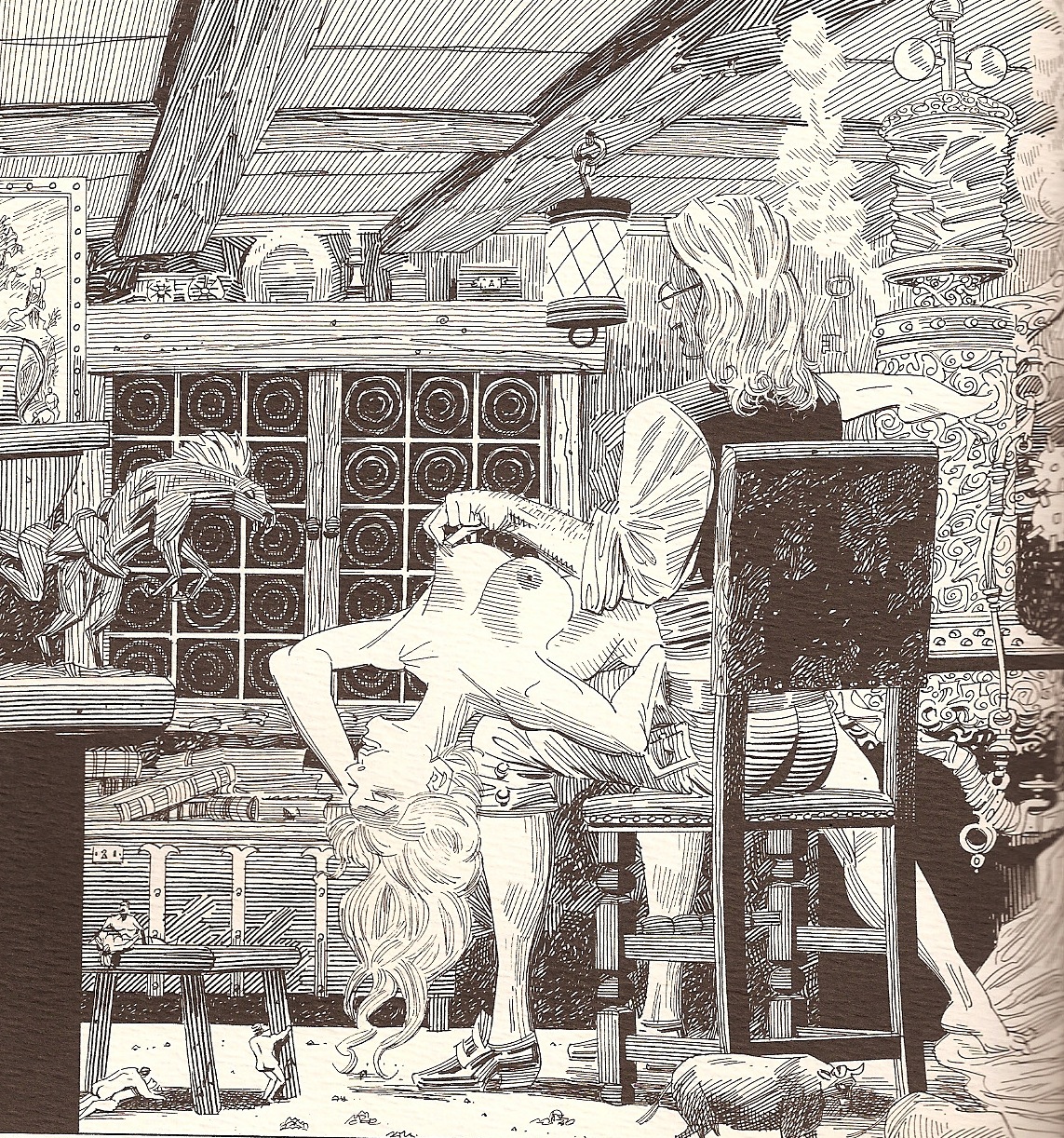
Graphic gratuitousness, from LOEG: The Black Dossier
To suggest that Moore’s increasing interest in sexuality is merely an excuse to get artist Kevin O’Neill to draw some dirty pictures for him is unfair, however, since the fascination with sexuality is clearly linked to an almost Romantic obsession with the liberating powers of the imagination. The “Blazing World” section that closes the book presents readers with a utopian “magical kingdom” of fantastic fictional creations, symbolically representing the scope and power of the human imagination, frequently repressed or ignored in the “real world.” That is, while Moore’s LOEGverse is already only populated by fictional creations (James Bond, Hugo Drummond, Emma Peel, Wodehouse’s Jeeves, etc. all make memorable appearances in The Black Dossier), there is a constant implication that in this “real world” the most imaginative of imaginative creations are slowly being pushed out, due to oppressive social policies and a general incapacity (or unwillingness) to access the most powerfully imaginative parts of our brains. England, in the 1958 LOEGverse is ruled by the dystopian Party from Orwell’s 1984, while fairies, sprites, and magical beings (apparently common in the LOEG Renaissance Britain) have either been exterminated or have fled to the “Blazing World” (from Margaret Cavendish’s novel of the same name). So, while Moore retains the trappings of the previous LOEG in giving us a world wherein all of the characters are other authors’ fictional creations, he also creates yet another world in which things are even more “fictional,” fantastic, and imaginative…turning the original LOEGverse into a dystopian lack of imagination and the “Blazing World” into its utopian flipside. Not coincidentally, the “Blazing World” also presents its readers with tantalizing sexual possibilities, including the union of Fanny Hill and Venus, the goddess of love, and a ménage in the offing between Quatermain, Murray, and Orlando. All of which brings us, at long last, to my erstwhile brother’s project on this website of “the gay utopia” and it’s problematic application in Moore’s graphic novel.
What does Moore’s pornographic fascination with and valorization of polymorphous and androgynous sexuality have to do with his equal fascination with the potential utopia of the human imagination? Presumably, the former is what my brother is labeling the “gay utopia,” a label I do not completely understand or endorse, since it is neither “gay” nor a “utopia” from what I can discern. Rather, it seems to be a version of “third wave” feminism, or “post-feminism,” or (perhaps) postmodern feminism as theorized by Judith Butler and Michel Foucault (and many others) and practiced by contemporary writers like Angela Carter, Jeanette Winterson, and Caryl Churchill (and many others), all of whom are transparently influenced by Woolf’s exploration of androgyny in both Orlando and A Room of One’s Own. Moore’s affinity with this group of writers is not only indicated by the central place of Orlando in Black Dossier, but also by the conspicuous placement of a poster advertising the performance of Fevvers, Carter’s androgynous winged circus aerialist in Nights at the Circus, on a poster in Quatermain and Murray’s seedy hotel room.
Woolf’s discussion of androgyny in the final chapter of A Room suggests the possibility that all people are both male and female, and that it is, in some sense, “unnatural” for us to think of ourselves as linked to one gender or the other. Rather, Woolf suggests, many of the problems with contemporary writing is in its “unnatural” sex consciousness, most likely caused by the women’s suffrage movement and the proprietary masculine response to it. While much of A Room, then, is spent detailing various oppressions of women (particularly economic and educational deprivations) that have presented the flowering of female genius in the field of writing, she ends by advocating the dissolution of the gender categories which make such oppression possible. If we do not think of ourselves as male or female, it would, no doubt, be impossible to deprive certain members of society certain privileges on the basis of gender. Logically, it would also dissolve the notion of default “norms” of sexual orientation, since sexual attraction would be based on a much looser sense of both our own gender and that of our partner(s). Again, it would be impossible to oppress people on the basis of the gender of the person we choose to sleep with if gender itself were not an operable category. Woolf herself doesn’t explore the sexual ramifications of this notion of androgyny in A Room (she tended to be fairly reticent in portrayals of and discussion of sex), although there is a bit more of this kind of thinking in Orlando, wherein the hero/ine falls in love with women, men, and other metaphorically androgynous characters (who likewise fall in love with her/him). None of this seems to shatter Woolf’s fundamental belief in gender, however, since she insistently suggests that there is something “special” and “suggestive” about women’s writing that is simply absent from the majority of male output. That is, while it is essential for women to forget that they are women while writing, that writing will still be characteristically feminine. All of which is to say that Woolf herself never quite asserted that gender did not exist in some kind of fundamental/natural way, just that gender consciousness had taken a far-too-prominent role in human society.
Not to fear, however, because these fairly limited suggestions about a possible “androgyny of the mind” become a full-fledged denial of the existence of the male/female gender division in post-structuralist (and post-post-structuralist) thinkers like Foucault and Butler. To boil down the highly influential thought of both theorists into two words, gender and sexual orientation become matters of “discourse” and “performativity.” For Foucault, of course, there are no natural or “essential” truths. Rather, “truth” is a matter of social agreement, or what people “say” in a variety of discourses. In his History of Sexuality, Foucault details how certain sexual practices are described through discourse (and therefore authorized) as “normal,” while others are labeled as “abnormal.” Implicit (and occasionally explicit) in this argument is that there is no “real” normal, just what people have labeled as “normal” through discourse, all of which provides the impetus and the practice of the “specification” of and oppression of the “perverse”: the gay, the pedophiliac, the practitioner of bestiality, etc. The attribution of these behaviors as “abnormal” is primarily a practice by which societies label and specify an abnormal “other” which serves to justify and valorize the “normal” self of any community. The normal/abnormal binary then authorizes and excuses various forms of oppression.
While Foucault is more interested in “sexuality” than in gender, his general argument works just as well for these categories. There is no such thing as “natural” sex or gender divisions, the argument goes. Rather, the binary is created in discourse as a means of defining the masculine (normal, complete, phallically endowed) self against the other (abnormal, lacking) that is the feminine. Those in power generate the most influential discourse, and these discourses perpetuate power relations by presenting social constructions (like gender) as biological fact. For feminist thinkers following poststructuralist thought (third wave feminists in Julia Kristeva’s formulation), then, resistance to masculine dominance becomes less a matter of advocating for economic, political, or educational equality, and more a matter of exposing the fact that gender is a false category that merely perpetuates certain power relations. Presumably, exposure of this “false consciousness” will lead to a revolution of the mind that would put an end to oppression on the basis of these categories (gender, perversion) and lead to some kind of gender-free utopia. Foucault’s own position on this is never this optimistic, however, since he argues that any discourse is by its nature “disciplinary” or oppressive, and so a change in discourse about sexuality would not free us from oppression, but merely deliver us into a new form of it.
Butler’s claim in Gender Trouble (1990) is somewhat more positive, however, since it hinges on the liberating potential of “performativity” and not on the inherently oppressive power of discourse. For Butler, as with Foucault, gender categories are inherently false. In fact, Butler denies the typical division of “sex” and “gender” with the former referring to biological/natural differences between men and women (chromosomes, genitalia, etc.) and the latter referring to socially defined “roles.” For Butler, while chromosomal and genital differences may exist, it is a social (discursive) decision to use these categories that divide a society. We might just as easily call all blondes “male,” and all brunettes “female” and ignore the differences we now use to distinguish male from female just as we now ignore other kinds of differences between people (finger length, for instance). So, while differences between people may be “real” in some sense, the meaning of particular differences is never natural, essential, biological, or ontological. Butler argues the “gendered body…has no ontological status apart from the various acts which constitute its reality” (2497) and that this “fact” is the essential definition of performativity. Our sex/gender, she argues, is only a collection of acts within a social discourse. Drag queens and transvestites, then, become her primary examples, since their “internal” essence is so easily confused with their “external” act. Quoting Esther Newton, Butler notes how drag queens may be read as female on the outside (clothing), but really male (since they have genitals, Y chromosomes, etc.), or they may be read as male on the outside (in their bodies), but female on the inside (in their “soul,” their “self,” their primary self-identification). Butler notes then that drag, while an imitation of gender, also reveals how all gender is imitative: “In imitating gender, drag implicitly reveals the imitative structure of gender itself- as well as its contingency. Indeed, part of the pleasure, the giddiness of the performance is in the recognition of the radical contingency in the relation between sex and gender in the face of cultural configurations of causal unities that are regularly assumed to be natural and necessary.” (2498). Again, as with Foucault, gender/sex is revealed not as “natural” and “biological” but as a social construction of discourse. If we only see these constructions, then, we can perhaps act outside of them, performing the gender we wish to perform (including, perhaps, androgyny, or some other gender outside the male/female binary) and not be constricted by discourse. As with much thought I think of as postmodern, the primary claim here is for the “lack of reality of reality” (Lyotard 146), or the revelation that things we think of as “real” (sexual orientation, gender/sex) are in fact not real at all, but are instead mere social agreement that would change if we (as a society) were merely able to “imagine otherwise.” If, as a culture, we could shift our attention away from binary divisions like normal/abnormal, hetero/homo, woman/man, etc. the oppressions that arise from these divisions might be avoided, subverted, or destroyed. As Butler argues “gender is a performance with clearly punitive consequences” (2500) and presumably if “gender” were eliminated, those consequences would be alleviated.
While Foucault’s discussion of unavoidable discourses from innumerable intersecting power structures may be unnecessarily draconian (you’re oppressed by discourse, but there is no way out!), Butler’s discussion of drag and performance may be unrealistically utopian (despite the fact that Butler always keeps an eye on the oppressive discourses that construct gender). By suggesting that “performance” is the most operative word in discussions of gender and sexuality, she implies that if we all start “performing” in opposition to dominant power structures, such structures would dissolve. Moore’s Black Dossier and Lost Girls seem to operate within that logic. By presenting us with a cornucopia of sex acts, sexual attractions, and shifting genders, Moore works to undermine typical oppressive divisions like male/female and homosexual/ heterosexual, particularly in his clever division of the “real” LOEGverse and the “Blazing World,” the latter of which is only clearly viewable with a pair of included 3-D glasses. Again, the message seems to be that a shift in perspective (from the two dimensions of the league to the 3 dimensions of our world, through the 4th dimension of time, and finally to the supposed 5th dimension of the “Blazing World” wherein the characters experience all times simultaneously). The possible simultaneity of time is a standard element of Moore’s work (from Dr. Manhattan in Watchmen to Jack the Ripper’s multi-temporal experiences in From Hell), as is kinky and non-conformist sex (perhaps the most vivid example being Abby Cable’s intense and sweaty sex with a vegetable in Swamp Thing). The two are brought together most clearly in the final section of The Black Dossier, however, wherein it becomes clear that a shift in dimension, an escape from viewing time as linear, gives a fresh perspective, allowing us to see gender itself as not “real” and therefore available to re-vision.
This is particularly the case because although the “Blazing World” represents vivid and imaginative fiction, the restrictive oppressive world of the “real” LOEGverse is clearly just as fictional as its Blazing counterpart. Both are populated by fictions. It is merely the case that one of these fictions reinforces typical gender binaries and oppressions, while the other frees us from them, that separates the two. Ian Fleming’s James Bond (called merely “Jimmy,” no doubt for copyright reasons) is the key character in this regard in the “present” section of the real LOEGverse. His brutal violence and misogynist attitude towards both Mina and Emma Peel (of the Avengers) suggests the standard gender divisions and gender oppressions that exist in our own “real” world. At the same time, his obvious fictionality reminds us that these attitudes are also “fictions” in their own way, constructions of social discourse without recourse to “essential” reality. Of course, any character in a “novel” is a fiction, but Moore’s characters are made more obviously so by the fact that he is appropriating them from other people’s fictions. This self-referential indication that one’s creations are “texts” not “truths,” is a staple of “postmodern” fiction, of course, but it not mere textual game-playing here (although it appears to be in parts of the other League volumes). Rather, it serves the post-feminist agenda of suggesting that sex/gender and sexual orientation are themselves fictions. The polymorphic sexuality of Orlando is then set against the misogynist heterosexuality of Bond, both as fictions from which we can choose, but only one of which has a proven track record of oppression and abuse. It is in this way that The Black Dossier’s utopian dimension functions: as a “real” choice between two discursive fictions, not as a choice between quotidian reality and liberating imagination. As Prospero/Moore heavyhandedly notes in his final speech, our reality is at least as much a fiction as our imaginative creations. Nevertheless, in The Black Dossier, Moore makes the choice between these two fictions too easy and too reductive.
In any accounting of gender in a postmodern context, it is important not to too easily adopt a utopian perspective about the liberating potential of gender performance without also acknowledging the pervasively restrictive power of discourse and the possibility of additional restrictions of biology/nature, which may be too easily disregarded by radical social constructivists like Butler and Foucault. Grant Morrison, another comics “star,” provides a similarly utopian outlook in The Invisibles, which also combines explorations of the simultaneity of time, extra-dimensional perception, existential freedom of consciousness, and trans-gender androgyny. (Really, he and Moore may as well be the same person for all their personal squabbling). In the Apocalipstick story arc, the transvestive Lord Fanny can only gain her eldritch powers if she can “fool” a Mexican goddess-figure into believing that s/he is a girl. S/he stabs herself near the groin, fooling the extra-dimensional creature into believing that s/he is menstruating and thus gains his/her superheroic powers. As in Black Dossier, Morrison seems to suggest that gender is a matter of performance and self-identification, available for vision and re-vision, given the proper perspective (again from a 4th or 5th dimensional angle in the majority of the story). Neil Gaiman’s Sandman: A Game of You, while less giddy and inventive, may provide a reparative to this perspective, however. In this story, a witch gathers together the various women in an apartment complex to rescue one of their sisters from the “evil” Cuckoo. Wanda, a pre-operative transsexual formerly named Alvin, prepares to go with them, but is denied access to the dream realm because, well, he still has a penis. While Gaiman’s story (like Moore’s, like Morrison’s) is largely about the freedom to choose one’s identity, to perform the self, and to resist social discourse and definitions, here this possibility is ultimately defeated by the intractable reality of Wanda’s gender. In this case, the goddesses cannot be “fooled” or convinced by performance. Indeed, Wanda’s inability to accompany his friends leads inexorably to her/his death. Gaiman’s cautious pessimism indicates a less “postmodern,” and perhaps more realistic approach to gender oppression. Imagining gender differently, while possible and potentially liberating, doesn’t necessarily make certain “realities” disappear. Indeed, even if sex/gender are merely products of social discourse, there is no “Blazing World” that we can access in which such discourses disappear. Rather, discourse may be just as intractable as biology.
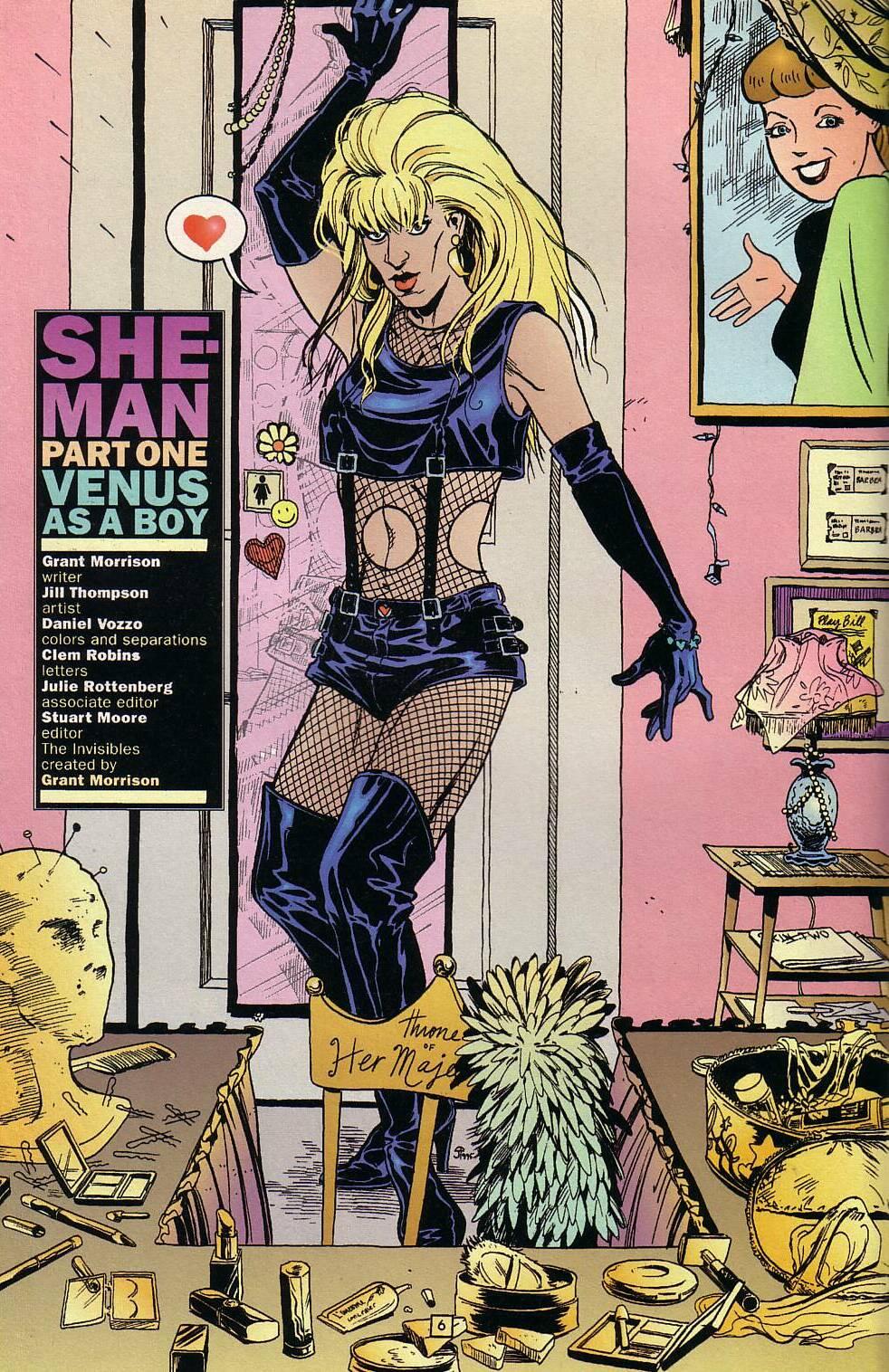
Morrison in Moore drag.
The Invisibles ©Grant Morrison and Jill Thompson
Most works of postmodern feminist fiction acknowledge these substantial barriers to gender liberation more clearly and more comprehensively than Moore’s does, and this is one of the primary failings of Black Dossier. Indeed, Woolf’s Orlando, written almost eighty years (and thousands of pages of feminist theory) before Black Dossier, is already more sophisticated on these issues than the later book. When Orlando emerges from her male to female sex change, she initially has no sense of her own gender while living among a group of gypsies. As soon as she returns to English society, however, her new gender has a significant impact upon her life. The juxtaposition of the “civilized” English with the “natural” gypsy culture gives Orlando (and Woolf) the opportunity to configure gender as something that rises out of social discourse, while Orlando’s experiences as both man and woman allows him/her to act as both despite the fact that s/he “remained exactly as he had been” (138). Orlando then is able to experience the freedoms of dressing as a man at night, while remaining a woman in the day during periods of the 18th century. At the same time, however, her activities and opportunities, particularly social and economic, are drastically curtailed as a woman, and her marriage (to a more ambiguously androgynous man) is described not merely in terms of love, but also in terms of social compulsion and as the “jaws of death” (262). That is, despite being Woolf’s most “utopian” novel, exploring as it does freedom from gender, the possibility of androgynous and lesbian love, and emergence into a new “present” that may evade the constrictions of the past, much of the novel is devoted to the depiction of these restrictions and the monumental power they have to control our sense of self and our daily actions. Woolf is more concerned in her work with the disciplinary nature of discourse about gender than with a performative utopian escape from those discourses.
Likewise, followers of Woolf, like Winterson and Carter, are less inclined to display a utopian dimension without counterbalancing it with a more “realistic” reparative. Carter’s Nights at the Circus (cited in Black Dossier) contains an androgynous heroine (Fevvers) and an increasingly androgynous man (Walser) who get married (like Orlando and Shel) and declare the possibility of a utopian future led by Fevvers as “New Woman”. Still, the book focuses at length on a variety of patriarchal abuses, including the merciless beating of one character, Mignon, by a series of men. These abuses are accompanied by sardonic critiques of a utopian mindset by Fevvers’ lifelong companion, Lizzie. Similarly, Jeanette Winterson’s Sexing the Cherry, which, like Black Dossier, contains meditations on the simultaneity of time as part of its feminism, provides us with a more ambiguously heroic androgynous heroine. The Dog Woman’s excessive enjoyment of and reveling in violence makes the reader begin to think that her feminist resistance to masculine discourse results not in “freedom” from gender binaries and oppression, but in a new era of oppression, violence, and abuse that merely reverses the male/female terms rather than erasing them. In depicting matters in this way, there is some suggestion that such an erasure of the gender binary may be impossible. Winterson’s The Passion also contains an androgynous heroine, Villanelle, whose webbed feet are signifiers of masculinity, while her genitalia/chromosomes suggest otherwise. Her liberation from an abusive marriage doesn’t result in freedom/happiness, however, at least not for all, as Henry (her friend and murderer of the husband) ends up on an island insane asylum, much like his previous “love,” Napolean.
Similar ambivalences are available in Caryl Churchill’s play Cloud 9, whose very title suggests a utopia, but whose contents are more conflicted. While the first act focuses on repressive Victorian gender and racial discourse, the sexual fantasmagoria of the second act is surprisingly less liberated than one might expect. While the first act is dominated by simple oppressive binaries of race and gender (complicated by transgender casting), the second act is dominated by homosexual affairs, followed by various ménage a trois, and finally by incestuous and inter-generational orgies. None of these physical acts seem to free their participants from the discourses of patriarchy available in Act I, however, as two gay men quickly adopt typically “masculine” or “feminine” roles, while the matriarch of the family, Betty, continues to want to serve men even after she leaves her husband and discovers the liberating pleasures of masturbation. That is, while Churchill’s play clearly views gender and sexual orientation as both discursive and performative, she is not so quick to suggest that a sudden shift in perspective, or trip to a “Blazing World” will make liberation from circumscribed gender conceptions possible.
None of this is to suggest that Moore is completely devoid of irony or self-critique. One humorous aside notes that when Orlando is male, he has a tendency to become increasingly violent, while a brief Tijuana Bible from the 1984 years depicts a man declaring, in the middle of a sexual act, “Ahh! Yes! In this moment of timeless animal love, we cast off our shackles!” That this sex act is immediately followed by betrayal by his partner and submission once more to the totalitarian government, seems to suggest the folly in believing that a series of diverse sexual practices will somehow “free” us from the discourses that determine social “norms” like gender and sexual orientation.
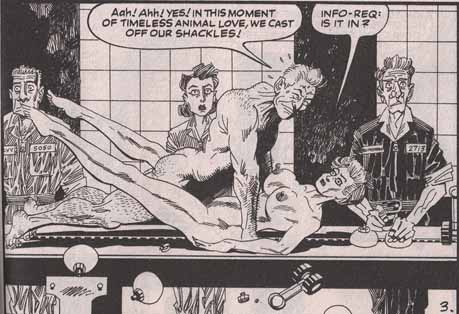
Still, despite this ironic disavowal of such unalloyed utopian notions, this is precisely the idea that The Black Dossier most frequently represents. The key first movement of a new consciousness in post-feminist thought is the realization that gender (and sexuality) are social constructs that can be ignored and re-invented. The result of this, perhaps, would be an openness to polymorphous sexuality and more various gender-identity. Moore’s book, however, seems to suggest that exposure to polymorphous sexualities and gender-identities will somehow lead us to an acknowledgment of gender’s inherent falsehood. While Black Dossier thematizes the fictionality of gender, it more often shows us lots of sex (especially in the first third of the book), a practice that tends not to serve the interests of post-feminism, but instead has the reverse effect. Mostly, what readers of the book are given (and it is a given, in the world of mainstream comics, that most of those readers are male) is a plethora of beautiful women in various states of undress, performing sex acts with men and/or other women. Rare is the depiction of homosexual male intercourse, and rarer is the depiction of sex that doesn’t conform to what might be typically titillating to men. Women are quite consistently, and especially in the Orlando and Fanny Hill sections, on display for men to ogle and appreciate, with the more serious ideas about the value of gender re-evaluation likely missed by many if not most readers. Nowhere is this problem more clear than in the Fanny Hill section in which one page (and its only picture) are devoted to a society in which all women walk around naked, while the men are fully clothed. While it is possible to view this as a commentary on the socially-derived convention of wearing clothes (and its ridiculousness in warmer climates), it is more likely to be read as an opportunity for mostly male readers to look at pictures of naked women. It is hard to construe this as a step for feminism. While, again, it is possible to argue that Moore seeks to be true to the style of his source material, reproducing such source material in an effort to advocate overcoming it is a problem typical of postmodern pastiche.
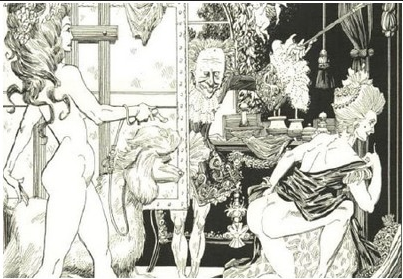
The exact same problem emerges in Moore¹s treatment of race. The “rescue” of Murray and Quatermain performed by the blackface sambo-style doll, the Golliwog (a character in children’s books by Florence Upton and Enid Blyton, the latter a favorite of Moore’s), may be read as an effort to promote the possibility of “reimagining” racial stereotypes in positive ways. Given the lack of critical distance, or self-conscious discussion, in the book itself, however, the portrayal of the Golliwog seems more consistent with racist caricatures than in opposition to them. Given Moore’s sketchy history of representing race (the zombie issues of Swamp Thing, the firedrake in Miracleman), there is little in Black Dossier to suggest that racist representations are under critique. Instead, the Golliwog is presented as an imaginative “hero,” instead of as a typically white failure of the imagination. The problems of racial politics inherent in the use of the Golliwog should, at the very least, be explored, just as the contradictions inherent in a man presenting naked women for the viewing/reading of other men should be considered, before claims for the inherent “liberating” power of Moore’s (or anyone else’s) imagination can be taken seriously. None of this is to suggest Moore is a “racist” or a “sexist” in any kind of easily attributable way. His left-wing credentials are, indeed, well-established. Instead, the Black Dossier seems to assert a bit too easily that intractable social problems (like racial and gender discrimination) can be overcome with a little fifth dimensional imagination, a notion that is offensive in itself.
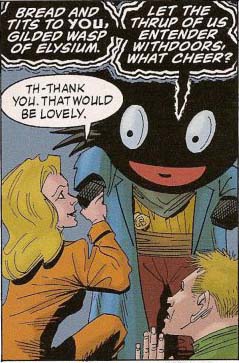
White people are so imaginative!
Overall, The Black Dossier is a disappointment in almost every way. The playful integration of Victorian fictional characters in the previous volumes is replaced by an exhaustive encyclopedic attempt to integrate nearly all fiction into one world. The sex doesn’t reach the erotic excesses of Lost Girls, but retains many of the philosophical problems associated with pornography. The meditations on the freedom of the mind are less compelling and less complex than Moore’s early ruminations on anarchy in V for Vendetta or his vision of an unavoidably repressive utopia in the closing issues of Miracleman. Moore’s engagement with feminism and sexual freedom has been evident over the course of his illustrious career, but his most recent efforts to depict and promote a kind of utopian alternative to our vexed reality in Promethea, Lost Girls, and Black Dossier is both less entertaining and less insightful than his previous work, all of which contained fewer sex scenes.
Works Cited
Butler, Judith. From Gender Trouble. The Norton Anthology of Theory and Criticism. Ed. Vincent B. Leitch. New York: W. W. Norton & Company, Inc., 2001. 2488-2501.
Carter, Angela. Nights At The Circus. New York: Penguin, 1984.
Churchill, Caryl. Cloud 9. New York: Routledge, 1979, 1984
Foucault, Michel. The History of Sexuality: An Introduction. Trans. Robert Hurley. New York: Vintage, 1978.
Gaiman, Neil. Sandman: A Game Of You. New York: D. C. Comics, 1991-1992.
Morrison, Grant. The Invisibles, Vol. 1, #¹s 13-16. New York: D.C. Comics,
1995
Moore, Alan and Kevin O¹Neill. The League of Extraordinary Gentlemen: The Black Dossier. Wildstorm/America’s Best Comics, 2007.
Winterson, Jeanette. The Passion. New York: Vintage, 1987.
___. Sexing the Cherry. New York: Vintage, 1989.
Woolf, Virginia. Orlando. Orlando, FL: Harcourt, Inc., 1928.
___. A Room of One’s Own. Orlando, FL: Harcourt, Inc., 1929.


